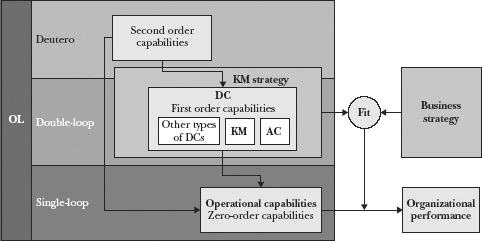In this section, we integrate existing work to propose relationships between our constructs of interest and firm performance. We define performance as the organization’s success or failure in achieving its financial and non-financial (e.g. quality, reputation, growth) goals. Our integrative model is shown in Figure 8.3.
Figure 8.3 Integrative Framework

Connecting learning types to the capability hierarchy
The study of organizational learning dates back to the 1930s, when the first work on organizational learning curves appeared (reviewed in Argote, 1999). Argyris and Schön might be considered the ‘founding fathers’ of the discussion about the learning types of which they identified three (Argyris and Schön, 1978). ‘Single-loop learning’ occurs when a mismatch between intended and obtained outcomes is detected and corrected without changing the underlying routines that govern the behaviors. ‘Double-loop learning’ occurs when a mismatch is detected and corrected by first changing the routines based on a new conception of the universe. ‘Deutero-learning’ is the second-order learning enacted on single- or double-loop, which can be described as learning to learn (Argyris, 2003). This typology has been clarified but not significantly challenged, modified, or connected to the new theories of knowledge and capabilities since its inception. Therefore, we based our theoretical development on the premise summarizing this conceptualization.
Premise: OL is a comprehensive process consisting of single-loop, double-loop and deutero- learning.
Since OL is conceptualized as a process, the process theory is an appropriate theoretical framework to employ. A typical process theory holds that similar inputs transformed by similar processes will lead to similar outcomes; that there are specific necessary conditions for the outcome to be reached. Thus, a process level explanation identifies the generative mechanisms that cause observed events to happen in the real world, and the particular circumstances or contingencies when these causal mechanisms operate (Van de Ven and Poole, 1995). Therefore, OL provides what Bunge (1997) calls a ‘mechanismic’ explanation, i.e. an explanation of the mechanisms which underline a particular relationship between constructs.
In contrast to process theories, content theories such as RBV, DC, and others prioritize nouns over verbs and provide conceptual explanations of organizational outcomes (Garud and Van de Ven, 2002). In this sense, content theories are more static than process theories.
Based on our foregoing discussion, we propose the following connection between OL types and different levels of capabilities. This explanation is visualized in Figure 8.3 via a multilayer rectangle representing different types of OL.
Proposition 1: OL is the mechanism for development or change of capabilities of any order (zero, first, second) whereby single-loop learning is related to zero-order capabilities, double-loop learning is related to first-order capabilities, and deutero-learning is related to second-order capabilities.
Easterby-Smith and Prieto’s (2008) model proposes that DC, as the first-order capability, modifies existing resources and routines over time, whereas OL, as the second-order capability, mediates between KM and DC and contributes to the evolution of both (see fig. 2 in Easterby-Smith and Prieto, 2008: 243). Our position is consistent with Easterby-Smith and Prieto’s approach, but differs from theirs in that we propose that the organizational learning system of processes—including single-loop, double-loop, and deutero-learning processes—is behind all levels of the capability hierarchy, and underlies the creation and development of dynamic capabilities (including knowledge management and absorptive capacity) and operational capabilities. This position is consistent with our argument behind Figure 8.2, when we concluded that organizational learning processes were the core elements behind the concepts of KM, DC, and AC. We summarize these propositions below.
Proposition 2a: OL is positively related to the development and change of DC (including KM and AC), and of operational capabilities.
Proposition 2b: DC (including KM and AC) is positively related to the development and change of operational capabilities.
In Figure 8.3, our visual representation also differs from Easterby-Smith and Prieto’s (2008) model in that it is presented as a series of cascading rectangles to highlight the idea of different levels (‘orders’) of capabilities that correspond to the different types of OL processes.
